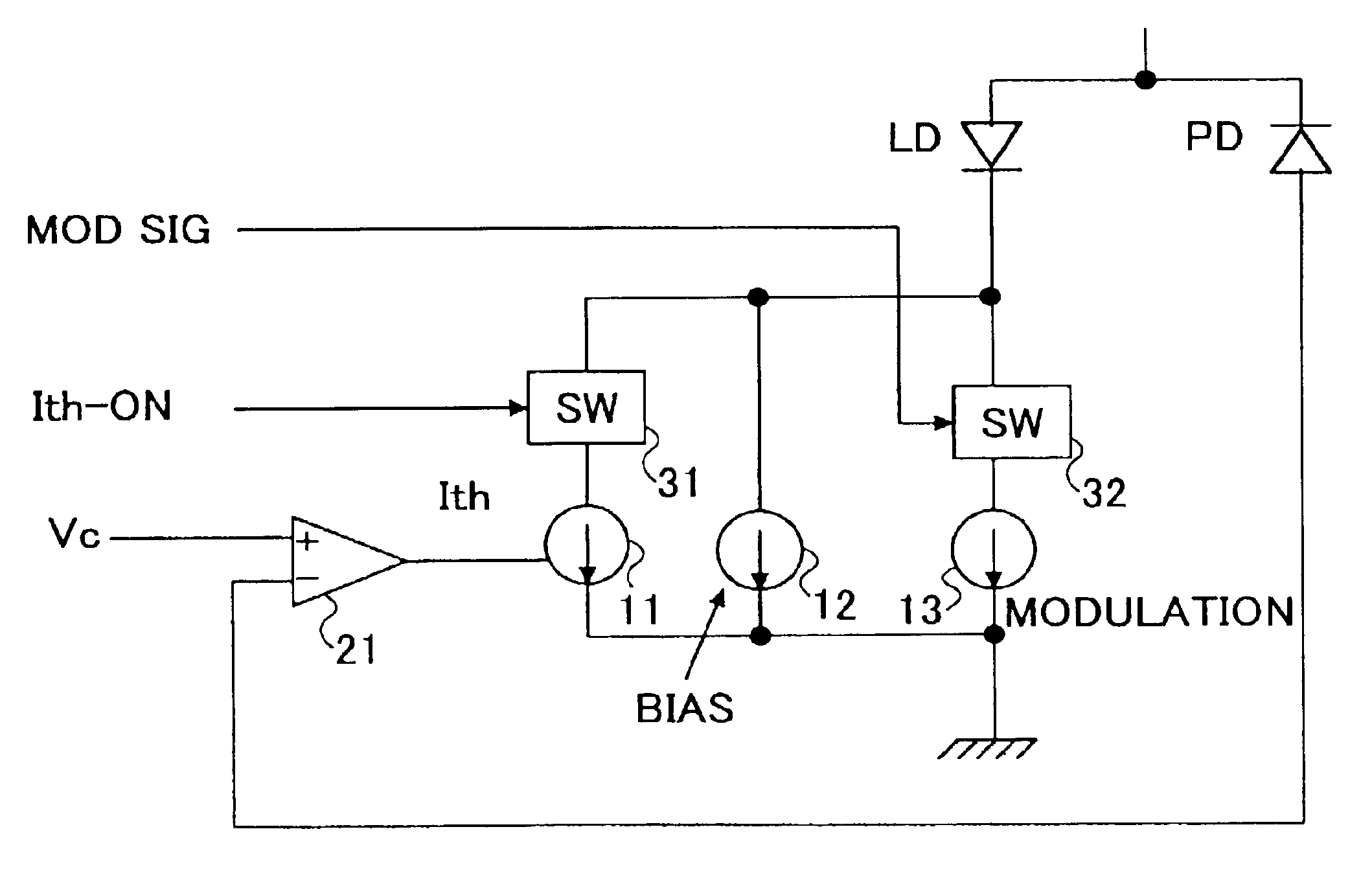Laser driver circuit
a laser diode and driver circuit technology, applied in the direction of laser details, semiconductor lasers, electrical apparatus, etc., can solve the problems of reducing the use of laser diodes such as non-bias driving, delay in optical emission timing, and negligible delay
- Summary
- Abstract
- Description
- Claims
- Application Information
AI Technical Summary
Benefits of technology
Problems solved by technology
Method used
Image
Examples
first embodiment
[First Embodiment]
[0104]In a first embodiment, the present invention utilizes the characteristics of laser diode and achieves the driving of the laser diode by a sum of the bias current, threshold current and the drive current. Here, the drive current is set very small contrary to the conventional bias driving of laser diode.
[0105]In the non-biased state, it should be noted that the impedance of a laser diode takes a considerably large value, and it takes some time for the laser diode to become ready for laser oscillation in the case the threshold current is supplied to an unbiased laser diode because of the large inductance component, and the like, of the laser diode.
[0106]When a very small bias current, a magnitude of 1 mA would be sufficient, is supplied to the laser diode, on the other hand, the impedance of the laser diode is reduced significantly, and the laser diode becomes quickly ready for oscillation upon supplying of the threshold current in superposition to the bias curr...
second embodiment
[Second Embodiment]
[0182]FIG. 17 shows the principle of a laser driver circuit according to a second embodiment of the present invention, wherein those parts corresponding to the parts described previously are designated by the same reference numerals and the description thereof will be omitted.
[0183]Referring to FIG. 17, the laser driver circuit the laser driver circuit has a construction similar to the one described with reference to FIG. 3 except that there is provided an auxiliary modulation current source 14 parallel with other current sources 11-13, and thus, the laser diode LD is driven with a sum of the drive currents produced by the current sources 11-14. Thereby, it should be noted that the auxiliary modulation current source 14 is tuned on for only a very short interval such as 0.5-5 nm at the beginning of operation of the modulation current source 13. Similarly as before, the bias current source 12 supplies a drive current of about 1 mA, not exceeding several milliampere...
third embodiment
[Third Embodiment]
[0222]Hereinafter, a third embodiment of the present invention will be explained. The present embodiment deals with a temperature change of the laser diode and provides a laser driver circuit that maintains the output power of the laser diode constant when the operational temperature of the laser diode has been changed.
[0223]In the conventional art explained before with reference to FIG. 2, the optical-emission level control signal Vc controlling the optical emission level of the laser diode LD in the activated state thereof and a monitor voltage Vm produced by the photodetector PD are used to form a differential signal, and the differential signal thus formed is used to control the level of optical emission of the laser diode LD at the time of the activated state of the laser diode. Further, a bias level control signal controlling the optical emission level of the laser diode LD in the deactivated state thereof and the operational voltage VLD of the laser diode ob...
PUM
 Login to View More
Login to View More Abstract
Description
Claims
Application Information
 Login to View More
Login to View More - R&D
- Intellectual Property
- Life Sciences
- Materials
- Tech Scout
- Unparalleled Data Quality
- Higher Quality Content
- 60% Fewer Hallucinations
Browse by: Latest US Patents, China's latest patents, Technical Efficacy Thesaurus, Application Domain, Technology Topic, Popular Technical Reports.
© 2025 PatSnap. All rights reserved.Legal|Privacy policy|Modern Slavery Act Transparency Statement|Sitemap|About US| Contact US: help@patsnap.com



